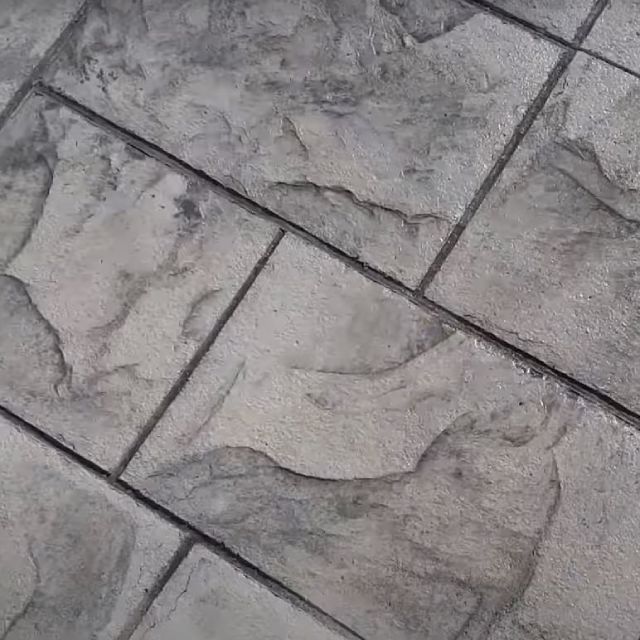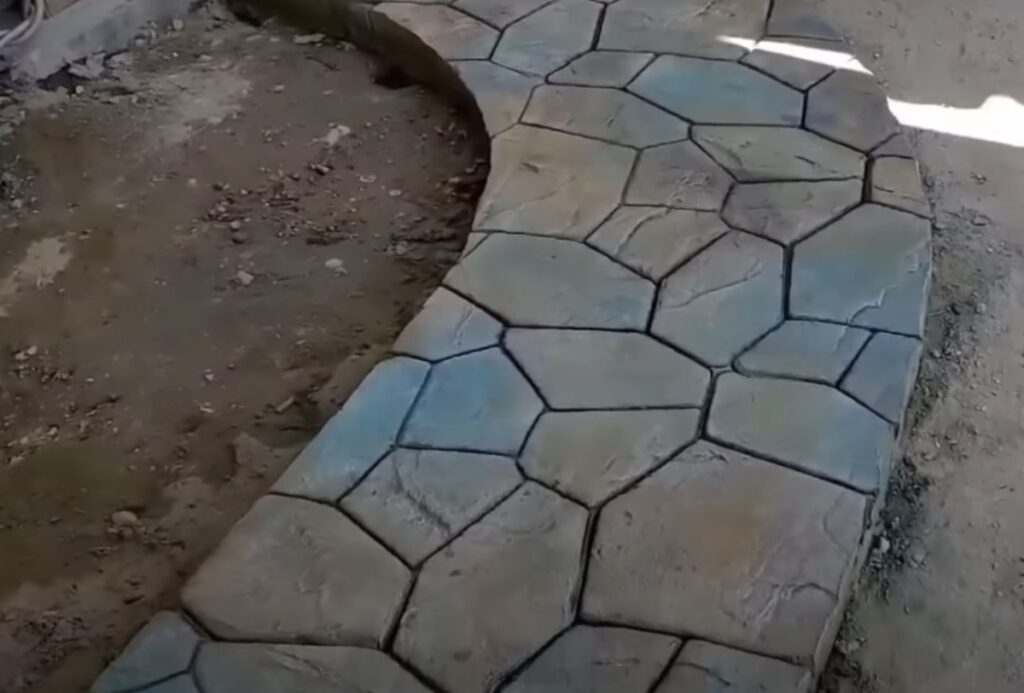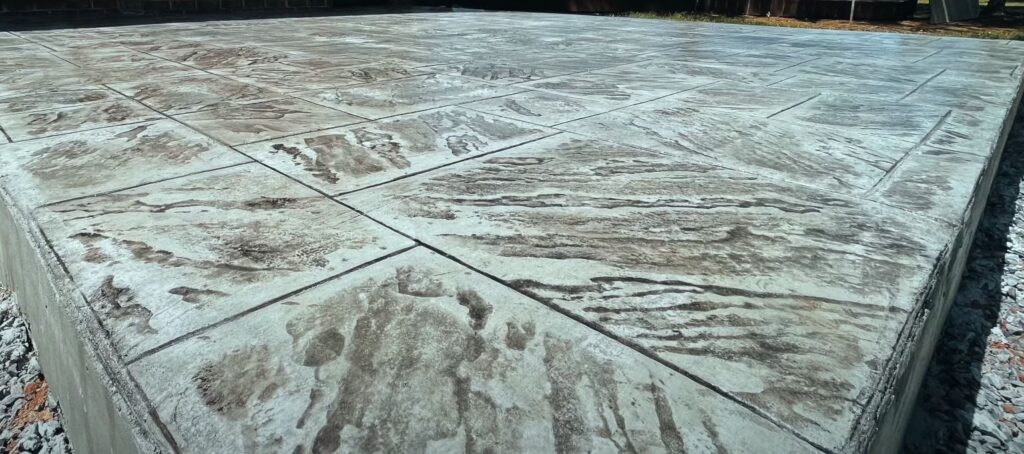Understanding Stamped vs. Stained Concrete
When delving into concrete options for your home, you’ll likely come across two popular choices: stamped and stained concrete. Both bring distinct characteristics and aesthetics to the table, but they’re quite different in their application and results.
Stamped Concrete: An Artistic Touch
Stamped concrete is all about creating textures and patterns. It involves pouring slab concrete and then impressing designs and textures into it while it’s still wet. This technique mimics the look of natural stone, bricks, or even wood. The versatility in design is a big plus. For instance, a driveway in Morningside could feature a cobblestone appearance without the high cost and maintenance of actual cobblestone.
- Design Variety: Offers a wide range of patterns and textures.
- Aesthetic Appeal: Mimics more expensive materials like stone or wood.
- Customization: Can be colored to match or complement your home.
Stained Concrete: Adding Color and Depth
Stained concrete, on the other hand, is more about color and less about texture. It involves applying stains to the concrete surface to add hues and vibrancy. There are two types of stains: acid-based, which react chemically with the concrete, and water-based, which provide more consistent color. Stained concrete in a suburb like Oteha can bring warmth and character to outdoor areas.
- Color Options: Wide range of colors, from subtle earth tones to vibrant shades.
- Unique Effects: Acid stains offer a mottled, variegated look.
- Versatility: Suitable for both new and existing concrete surfaces.
Health and Safety Aspects
When working with either stamped or stained concrete, it’s important to consider health and safety aspects. Stamping concrete involves heavy materials and machinery, and it’s crucial to follow safety guidelines to prevent injuries. Staining concrete, especially with acid-based stains, requires careful handling due to the potential for harmful fumes and chemical reactions.
- Safety Gear: Use of gloves, goggles, and protective clothing.
- Professional Handling: Especially important with acid-based stains due to chemical complexity.
- Ventilation: Necessary during the staining process to avoid inhaling fumes.
Auckland-Specific Considerations
In Auckland’s unique climate, both stamped and stained concrete have their place. However, the region’s variable weather patterns mean that the durability and maintenance of these surfaces should be considered. For example, in areas with higher rainfall, ensuring proper sealing and drainage is crucial to maintain the integrity of stamped patterns and the vibrancy of stains.
- Sealing and Maintenance: Regular sealing is essential to protect against weathering.
- Drainage Considerations: Important to prevent water damage and staining.
Choosing the Right Option for Your Auckland Home
Selecting between stamped and stained concrete depends on your specific needs and aesthetic preferences. If you’re looking for texture and the appearance of natural materials, stamped is the way to go. For color and a unique finish, stained concrete offers more options. In either case, consulting with a professional, like Professional Concrete Driveways Auckland, ensures that you get the best advice tailored to your specific location and requirements.
- Expert Consultation: Important for understanding local conditions and making the best choice.
- Professional Installation: Ensures durability and quality of the finished product.
- Custom Solutions: Tailored to your home’s style and Auckland’s unique environment.
In conclusion, whether you’re in the bustling streets of Morningside or the quieter suburbs of Oteha, understanding the differences between stamped and stained concrete can guide you in making the best choice for your property. With the right professional guidance, you can transform your space into something both functional and visually appealing.
Key Takeaways on Stamped and Stained Concrete
Distinct Techniques and Results Stamped concrete is primarily about creating textures and patterns on the concrete surface, mimicking natural materials like stone, brick, or wood. Stained concrete, in contrast, focuses on adding color and vibrancy to the concrete, with a range of hues available through acid-based or water-based stains.
Health and Safety Considerations Safety is paramount when working with both stamped and stained concrete. The use of heavy materials and machinery in stamping requires adherence to safety guidelines, while staining, especially with acid-based stains, demands careful handling due to potential chemical hazards.
Auckland’s Climate and Concrete In Auckland, the choice between stamped and stained concrete should take into account the local climate and environmental conditions. Issues like rainfall and humidity can affect the durability and maintenance of these concrete types, emphasizing the need for proper sealing and drainage.
Professional Guidance for Optimal Results Consulting with Auckland concreting professionals, such as those at Professional Concrete Driveways Auckland, is crucial for achieving the best results. Their concreter expertise ensures that the chosen concrete solution is not only aesthetically pleasing but also functional and suited to Auckland’s unique environment.
Questions on Stamped vs. Stained Concrete
What Are the Main Differences Between Stamped and Stained Concrete?
Stamped concrete is all about texture and patterns, creating a three-dimensional look that mimics other materials like stone, brick, or wood. Stained concrete, on the other hand, focuses on color, offering a wide range of hues that can be applied to the concrete surface for a vibrant or subtle effect.
How Do Stamped and Stained Concrete Fare in Terms of Durability?
Both stamped and stained concrete are durable options, but their longevity can be influenced by factors like installation quality, environmental conditions, and maintenance. Regular sealing and proper installation are key to ensuring that both types of concrete withstand the test of time.
Are There Specific Health and Safety Concerns to Consider?
Yes, there are health and safety considerations for both types. Stamped concrete involves heavy machinery and materials, requiring safety precautions during installation. Staining concrete, particularly with acid-based stains, involves handling chemicals and demands caution to avoid skin and eye contact and inhalation of fumes.
Which Concrete Type is More Suitable for Auckland’s Climate?
In Auckland’s variable climate, both options can be suitable, but it’s essential to consider factors like rainfall and humidity. Proper sealing and maintenance are crucial for both stamped and stained concrete to protect them from weather-related wear and tear.
Can Stamped and Stained Concrete Be Customized?
Absolutely! Stamped concrete offers a variety of patterns and textures, while stained concrete comes in a wide range of colors. This allows for high levels of customization to match the specific aesthetic and design preferences of any project.
Is Professional Installation Recommended?
Yes, professional installation is highly recommended for both stamped and stained concrete. Professionals ensure proper application, adherence to safety standards, and consider local conditions like Auckland’s climate, which are crucial for the longevity and appearance of the concrete.
What Maintenance is Required for Stamped and Stained Concrete?
Maintenance needs differ slightly between the two. Stamped concrete generally requires resealing every few years to protect the surface and maintain its appearance. Stained concrete, especially if it’s in a high-traffic area, might also need periodic resealing to preserve the color intensity and prevent fading.
Can These Concrete Types Be Used Indoors and Outdoors?
Both stamped and stained concrete are versatile and can be used in indoor and outdoor settings. Stamped concrete is often preferred for outdoor spaces like patios or driveways due to its durability and texture. Stained concrete is popular for both interior floors and outdoor areas, offering a range of colors that can complement various design styles.
How Long Do These Concrete Finishes Last?
With proper installation and maintenance, both stamped and stained concrete can last for decades. The longevity largely depends on the environment they’re in, the level of foot or vehicle traffic, and how well they are maintained.
Are Stamped and Stained Concrete Slippery?
This can be a concern, especially when wet. Stamped concrete, due to its texture, generally offers better slip resistance. For stained concrete, especially in areas like pool decks or patios, it’s often recommended to add a non-slip additive to the sealer for extra safety.
How Much Do Stamped and Stained Concrete Cost Compared to Regular Concrete?
Both stamped and stained concrete are typically more expensive than regular concrete due to the additional materials and labor involved in the finishing process. However, they offer aesthetic benefits that regular concrete doesn’t, potentially increasing property value and curb appeal.
Is it Possible to Combine Stamped and Stained Concrete?
Yes, combining stamped and stained concrete is possible and can create unique and visually appealing results. For example, a stamped pattern can be enhanced with staining to add depth and color variation, mimicking natural stone or other materials more realistically.
How Eco-Friendly Are Stamped and Stained Concrete Options?
Concrete, in general, is a sustainable material due to its durability and longevity. Stamped and stained concrete can be considered eco-friendly options, especially if using water-based stains and sealers with low volatile organic compound (VOC) emissions. However, the environmental impact also depends on the production methods and transportation of materials.
How Does Weather Affect Stamped and Stained Concrete?
Extreme weather conditions can impact both types of concrete. In areas with frequent temperature fluctuations, stamped concrete may crack over time. Stained concrete, particularly if not properly sealed, might fade or discolor due to prolonged exposure to sunlight or heavy rain.
What Are the Design Limitations of Stamped and Stained Concrete?
While stamped concrete offers a variety of patterns, it may not always precisely mimic the natural materials it’s trying to replicate. Stained concrete provides a broad color palette, but achieving an exact color match can sometimes be challenging due to the natural variations in concrete.
How Does the Installation Process Differ Between the Two?
Stamped concrete requires stamping tools to imprint patterns before the concrete sets. This process is labor-intensive and requires precision. Staining concrete involves applying color either before the concrete sets (integral coloring) or after (acid or water-based stains), which is generally less labor-intensive than stamping.
Can Stamped or Stained Concrete Be Repaired or Altered?
Minor cracks in stamped concrete can be repaired, though it may be difficult to perfectly match the original texture and color. Stained concrete can also be re-stained or touched up if the color fades or is damaged, but major repairs might require resurfacing.
Are There Any Special Considerations for Pets and Stamped or Stained Concrete?
For pet owners, it’s important to note that both stamped and stained concrete surfaces can be easy to clean and resistant to pet stains. However, the texture of stamped concrete might be uncomfortable for some pets to walk on, and acidic stains should be applied with caution to ensure pets are not exposed to harmful chemicals.
How Sustainable Are the Materials Used in Stamped and Stained Concrete?
The sustainability of stamped and stained concrete largely depends on the materials used. Using locally sourced materials and eco-friendly stains and sealers can reduce the environmental footprint. Additionally, concrete’s durability means a longer life cycle, which is beneficial from a sustainability standpoint.
What Is the Best Way to Choose Between Stamped and Stained Concrete?
The best way to choose between stamped and stained concrete is to consider the desired aesthetic, the specific application, maintenance requirements, and budget. Consulting with a concrete professional can provide valuable insights into which option would be most suitable for a particular project’s needs.




